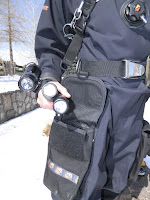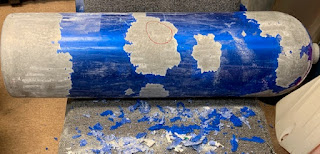Dive Like a Pro - Streamlining Techniques
 |
| Image: Odessa Stratton |
By Fred Stratton
Instructor & Repair Technician
fred@bubblesornot.com
 |
| Image: Odessa Stratton |
In the February and March articles, BC Basics Parts I and II, we discussed selecting a BC and becoming proficient in its use. We also addressed various diving tools and accesories, as well as where to mount them for rapid access while remaining hydrodynamically efficient. Let's build on that with some specific streamlining techniques.
Proper Placement
Why do you place your scuba accessories and tools where you do? Dive professionals likely influenced your initial decisions. Certain equipment placement is standardized across the dive industry based on best practices gleaned over the decades. Perhaps the most well known, and universally accepted, is placing one's alternate regulator (octopus) within the triangle beneath the chin and the corners of your ribcage.
 |
| Image: Odessa Stratton |
 |
| Image: Odessa Stratton |
 |
| Image: Fred Stratton |
Practice Develops Proficiency
Accessing and employing all your dive tools develops muscle memory so you act calmly and proficiently when you actually need them, particularly in an emergency situation when your adrenaline is elevated. Deploying your surface marker buoy (SMB) for the first time when you find yourself 75 yards downstream of your charter boat in a three-knot current is NOT advisable.
 |
| Image: Odessa Stratton |
Visualize Your Dive
Michael Jordan famously visualized entire games against his opponents before the tipoff. Try visualizing, with your eyes closed, a complete dive. During that dive reach for each piece of dive equipment in the sequence that you will or might need to use. Ask yourself these questions:
- Does the location of each component of my scuba system make sense?
- Can I access and deploy the equipment quickly?
- Which hand will I use to reach for the equipment?
If you are ascending with your LPI raised in your left hand and you get entangled, can you reach your cutting device with your right hand? Think about what you will need during each phase of the dive, what problems might arise, and how you will address the issue, calmly and resolutely.
How did your visualized dive go? Did you decide to modify your gear or change where you stow or mount equipment? If so, try diving the modified system in a pool or shallow open water. If it works, note the modification in your logbook, then update your buddy on the change.
 |
| Image: Odessa Stratton |
Primary or Back-up?
Cave and wreck divers take at least three lights on each dive, one primary and two back-ups. Obviously the primary light will be in use throughout the dive, with the back-ups only to exit the cave or wreck if the primary fails. Thus, your back-up lights must be securely stowed yet immediately accessible. Two cutting devices have become standard with many divers, placing them so the diver can access a cutting device with either the right or left hand.
Profile - Conestoga Wagon or Jet Fighter?
Settlers ventured west in the 19th century in horse-drawn wagons. They often strapped items such as buckets and tools to the sides of their wagons. That worked on the Oregon Trail. Not so much in the water. A modern jet fighter like the F-22 Raptor has its radar, radios, landing gear and weapons tucked inside the airframe in flight. We want to be jet fighters. "But where do I put all the stuff I need?"
 |
| Image: Odessa Stratton |
 |
| Image: Odessa Stratton |
Arms: computers, timing devices, curved slates
Harness: back-up lights, reels, canister light, lift bag, SMB
Back Plate or Butt Plate: canister light, SMB, lift bag, reels
Hoses - Too Long, Too Short or Just Right?
Low and high pressure (LP / HP) hoses come in lengths from 6" (15cm) to 84" (213cm). Most second stage regulators come standard with a 28" (71cm) hose. Because one size fits all? Definitely not. A hose that is too long will arc and dangle away from the body. A hose too short will restrict head movement to the left.
 |
| Image: Fred Stratton |
My wife is 4'10" (147cm) tall. A 28" (71cm) hose makes a wide arc away from her body, a dangerous entanglement hazard. A 24" (61cm) regulator hose is just right for her. (She uses a 40" (102cm) hose on her octopus.)
Consider the length of the hoses providing LP air to your 2nd stage regulators and LPI, and HP air to your SPG. Have your buddy note the location and arc of all your hoses. Do they dangle or arc away from your body? If so, talk to the BoN staff about customizing your kit with appropriately sized hoses. The cost is modest and you'll immediately notice the difference.
But Fred, what about the Hogarthian configuration and five or even seven-foot hoses? Great question. We'll explore technical configurations and which regulator to donate (the one in your mouth as you switch to the regulator on a necklace or the more traditional octopus donation technique) in a future article.
Continuing Education
By now you know Bubbles or Not Diving is a huge proponent of continuous learning. Instructors in each class you take will impart knowledge and expand your skills. Part of the mentoring and instructional process is helping each diver to fine tune her kit to increase comfort, safety and practicality. You'll really appreciate knowing your dive buddy's configuration during the PADI Rescue Diver class and technical classes such as the TecRec continuum.
Critique...and Be Critiqued
I've got hundreds of dives with my friend Bob Bennett and still we critique each other after every dive. Was any gear dangling? Could anything have impeded the rapid handoff of bailout cylinders in a low-on-gas emergency? What could we have done better?
Keep your critique constructive. Candor and civility build trust. That trust in each other will help you resolve problems as they arise. Document problems and how you resolved them in your logbook. This will reinforce the skills you applied and the lesson you learned from the dive.
* Special thanks to Odessa Stratton for editing and improving this article. *
Coming in May
Scuba Cylinders 101
Scuba Cylinders 101



Bubbles or Not is very eco-conscious which is important to me. I do not have a lot of dive experience, but am interested in learning more. Fred's writing gives a thorough explanation of gear and it's functionality for the novice and expert alike. I will definitely be back to this blog for some dive education!
ReplyDeleteHaving good streamlining, buoyancy control and tight gear configuration go along way to protecting delicate reef life and extend your diving enjoyment!
Delete